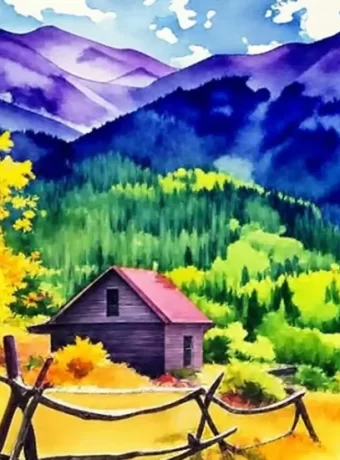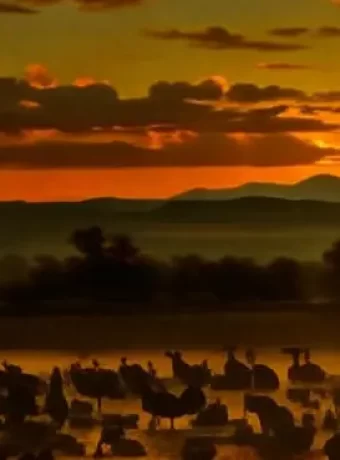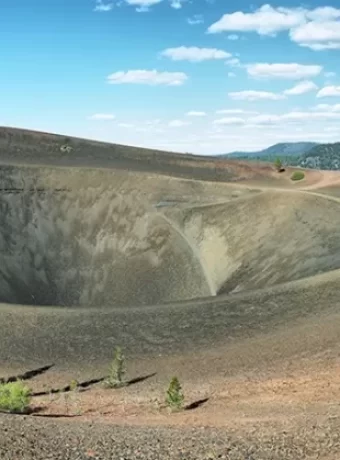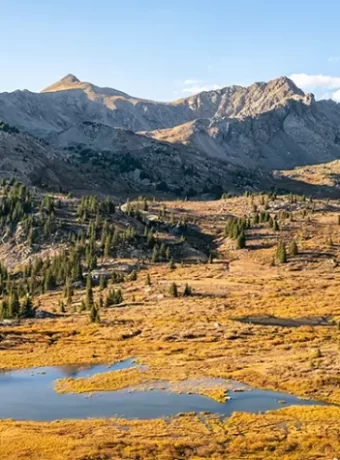Cody, Wyoming A Storied History, A Wild West Tale
Picture this: a rugged town nestled in the heart of the American West, where the spirit of the frontier still lives on. That’s Cody, Wyoming for you. Named after the legendary showman Buffalo Bill Cody, this town has a history that’s as wild and colorful as the man himself. From its early days as a frontier outpost to its modern-day status as a gateway to Yellowstone, Cody has always been a place where adventure and history collide.
But there’s more to Cody than just cowboy tales and rodeo legends. This town has a rich and complex past that’s shaped by the forces of nature, the ambitions of visionary leaders, and the grit and determination of generations of settlers and pioneers. So sit back, relax, and let me take you on a journey through the fascinating history of Cody, Wyoming.
Table Of Contents:
- History of Cody, Wyoming: From Buffalo Bill to the Wild West
- Exploring the Museums and Historic Sites of Cody
- The Shoshone River and Its Impact on Cody’s Growth
- Notable Figures in Cody’s History
- The Evolution of Cody: From Frontier Town to Tourist Destination
- FAQs in Relation to History Cody Wyoming
- Conclusion of History Cody Wyoming
- Rocky Mountain States Rich History in Ghost Towns and Fly Fishing Rivers
The History of Cody, Wyoming: From Buffalo Bill to the Wild West
Cody, Wyoming – a town that embodies the spirit of the Wild West. It’s a place where the legacy of the legendary Buffalo Bill lives on, and the frontier spirit still thrives. Imagine a town that started with just an idea. An idea from someone who wanted to create a special spot for adventure lovers, opportunity seekers, and fans of the raw West. Buffalo Bill, whose real name was William Frederick Cody, was more than just a showman. He was a visionary who saw the potential in this rugged corner of Wyoming. In the late 1800s, Buffalo Bill had already made a name for himself with his famous Wild West show. But he dreamed of creating something more lasting – a town that would embody the spirit of the West. And so, in 1896, he set out to make that dream a reality. Along with a group of investors, Buffalo Bill founded the town that would bear his name – Cody, Wyoming.
Founding of Cody in the Early 1900s
The early days of Cody were not for the faint of heart. This was a frontier town, where the only law was the law of the West. But Buffalo Bill had a plan. He knew that for the town to thrive, it needed to attract settlers and investors.

Grizzly Bear Graphic Hoodie as rugged as the West. Get yours today. UPF-50 sun protection, sewn in facemask.
Along with a group of investors, Buffalo Bill founded the town that would bear his name – Cody, Wyoming.
Founding of Cody in the Early 1900s
The early days of Cody were not for the faint of heart. This was a frontier town, where the only law was the law of the West. But Buffalo Bill had a plan. He knew that for the town to thrive, it needed to attract settlers and investors. So he set about creating a community that would be the envy of the West. He built the grand Irma Hotel, named after his daughter, which became the social hub of the town. He also established the TE Ranch, which became a model for ranching in the region.
The Influence of the Wild West on Cody’s Development
But perhaps the most significant influence on Cody’s development was the Wild West itself. Buffalo Bill’s Wild West show had already captured the imagination of people around the world, and Cody became a living embodiment of that romantic ideal. The town attracted cowboys, ranchers, and adventurers from far and wide. They came seeking the thrill of the frontier, the promise of opportunity, and the chance to be a part of something bigger than themselves. And as Cody grew, so too did its reputation as a bastion of the Wild West. Here’s a spot where rodeo stars shine bright. Add in top-notch hunting and fishing spots plus an undying independent streak – you’ve got quite the town. Today, present-day Cody still embodies that spirit. It’s a town that celebrates its heritage, its history, and its place in the annals of the American West. As I walk the streets of Cody, I can feel the echoes of that history all around me. The Irma Hotel still stands, a testament to Buffalo Bill’s vision. The TE Ranch still operates, a reminder of the town’s ranching roots. And the people of Cody still embody that frontier spirit – a spirit of independence, of resilience, and of a deep love for the land and the way of life it represents.
Exploring the Museums and Historic Sites of Cody
Cody, Wyoming is more than just a town – it’s a living museum of the American West. From the grand Irma Hotel to the world-class Buffalo Bill Center of the West, this town is steeped in history and culture. The Irma Hotel is more than just a place to stay – it’s a portal into Cody’s past. Built by Buffalo Bill himself in 1902, this grand hotel has been a fixture of the town for over a century. As you step through the doors, you’re transported back in time. The lobby is adorned with Western art and artifacts, and the rooms are decorated in a style that evokes the romance of the frontier. But the Irma is more than just a pretty face. You’ll find that here, history doesn’t just sit in books—it dances around you. Over the years, this hotel’s guest list has read like a who’s who of history and Hollywood – from commanders-in-chief to silver screen legends and even those unforgettable wild west icons. And if you’re lucky, you might even catch a glimpse of the hotel’s resident ghost – a friendly spirit named Irma, who is said to watch over the hotel and its guests.
Cody Heritage Museum: Preserving Local History
For a deeper dive into Cody’s history, head to the Cody Heritage Museum. Small in stature yet grand in spirit, here lies a haven for all things historic about our community – truly a gem worth exploring. Here, you’ll find exhibits on everything from the early days of the frontier to the heyday of the Wild West show. Picture this – walls adorned with vintage photographs next to displays of ancient firearms and the charming setup of a bygone era’s schoolhouse. But perhaps the most fascinating exhibit is the one dedicated to Buffalo Bill himself. Through personal artifacts and rare photographs, you’ll get a glimpse into the life and legacy of this legendary figure. No visit to Cody would be complete without a stop at the Buffalo Bill Center of the West. This world-class museum complex is dedicated to the history and culture of the American West, and it’s a must-see for anyone interested in the region’s past. The center comprises five museums in one, each focusing on a different aspect of the West. There’s the Buffalo Bill Museum, which tells the story of the man himself, and the Draper Natural History Museum, which explores the region’s wildlife and ecology. But perhaps the most impressive is the Whitney Western Art Museum, which houses an incredible collection of Western art, from classic paintings to contemporary sculptures.
The Cody Stampede Rodeo: A Tradition Since 1919
And of course, no visit to Cody would be complete without experiencing the thrill of the rodeo. The Cody Stampede Rodeo has been a tradition since 1919, and it’s still going strong today. Every summer, cowboys and cowgirls from around the country descend on Cody to compete in events like bull riding, barrel racing, and steer wrestling. You’re swept into the heart-pounding excitement of the Wild West – it’s unparalleled by anything else out there. But the Stampede is more than just a rodeo – it’s a celebration of Cody’s heritage and a testament to the enduring legacy of the American West. As I sit in the stands, watching the cowboys ride and the crowd cheer, I can’t help but feel a sense of connection to this place and its history. Cody may be a small town, but it looms large in the mythology of the West. With museums showcasing history, rodeos highlighting skill and bravery, and a collective spirit that never wavers—the story continues for all who come after us.
Cody Wyoming Travel Tip:
Cody, Wyoming, isn’t just a town; it’s a journey back to the Wild West. Founded by Buffalo Bill, its history is alive in every corner – from the historic Irma Hotel to thrilling rodeos and museums that celebrate Western heritage. It’s where adventure meets history, making Cody a must-visit for anyone captivated by the spirit of the frontier.
The Shoshone River and Its Impact on Cody’s Growth
From its earliest days, Cody has drawn vitality and spirit from the waters of the Shoshone River. It’s the reason Buffalo Bill chose this spot to build his town – he saw the potential for irrigation and growth. The river flows right through the heart of Cody, carving out the stunning Shoshone Canyon. There are four bridges that cross it, connecting the town and allowing access to Yellowstone’s east entrance. But the Shoshone is more than just a pretty landmark. It’s been absolutely critical to Cody’s development from the very beginning. Back in the 1890s, Cody was just a fledgling frontier town in the high desert of northwest Wyoming. Buffalo Bill knew that to attract settlers and help the town thrive, he needed to get the Shoshone’s water flowing to the arid land.
Present day Shoshone River is a great fly fishing resource. I have fly fished it on several occasions with great exuberance and enthusiasm from the trout hooked, released. As well as opportunities lost. My travel fly rod in the Rocky Mountains for most destinations is 9′ 6 weight fly rod.
The Cody Canal: Bringing Water to the High Desert
In 1895, Cody and a group of investors formed the Shoshone Land and Irrigation Company. Their first order of business? Digging the Cody Canal. Work began that fall on the canal, which would carry water from the South Fork of the Shoshone River to the east, irrigating the town site and surrounding farmland. Facing a hefty challenge didn’t stop them; they nailed it in the end. By May 1896, with the canal underway, the town site of Cody was officially laid out by George Beck and surveyor Charles Hayden. The Shoshone River and the new canal system made it all possible.
The Buffalo Bill Dam: A Feat of Engineering
But Cody wasn’t content to stop there. He had an even grander vision: a dam on the Shoshone River that would provide a steady supply of water for irrigation. Planning for the dam began in 1905, and construction was completed in January 1910. At 325 feet high, it was the tallest dam in the world at the time – a true engineering marvel. Imagine this – thanks to the Buffalo Bill Dam, we’ve got a massive pool of water that can soak into more than 100,000 acres of thirsty soil. It flipped the script not just for Cody but also for its neighbors. On the day the dam was finished, hundreds of Cody residents gathered to watch the final bucket of concrete being poured. They knew they were witnessing history in the making. Thanks to the Shoshone River, the Cody Canal, and the Buffalo Bill Dam, this once-arid region was transformed into a green oasis of ranches and farmland – and a thriving town that still proudly bears the name of its legendary founder.
Notable Figures in Cody’s History
Though named after a famed man himself, Cody wouldn’t be what it is without a handful of other memorable souls shaping its past and stories. Of course, no story about Cody would be complete without William F. “Buffalo Bill” Cody himself. The famous frontiersman and showman was the driving force behind the town’s founding and early growth. Born in 1846 in Iowa, Cody earned his nickname while working as a buffalo hunter to supply meat for Kansas Pacific Railroad workers. He went on to become a U.S. Army scout and a world-renowned entertainer with his “Buffalo Bill’s Wild West” show. But Cody’s true legacy may be the town that bears his name. He fell in love with the Bighorn Basin during a visit in 1894 and saw the potential for a thriving community. He invested heavily in the Shoshone Land and Irrigation Company and worked tirelessly to make his vision a reality.
Nate Salsbury: Buffalo Bill’s Business Partner
While Buffalo Bill was the face of the Wild West show, Nate Salsbury was the brains behind the business. A savvy marketer and manager, Salsbury helped make the show a massive success. He was also one of the founding members of the Shoshone Land and Irrigation Company and played a key role in the early development of Cody. Caroline Lockhart was a novelist, journalist, and prominent Cody resident in the early 20th century. She really threw her voice behind our town, putting in the legwork to get the Buffalo Bill Memorial Association off the ground. Lockhart was instrumental in commissioning the famous Buffalo Bill statue that still greets visitors today. She even helped choose the site and paid for the land out of her own pocket.
Gertrude Vanderbilt Whitney: Patron of the Arts in Cody
Gertrude Vanderbilt Whitney was a sculptor, art collector, and founder of the Whitney Museum of American Art in New York City. But she also left her mark on Cody. Whitney first visited the town in 1911 and fell in love with the rugged Western spirit. She became a major patron of the Buffalo Bill Memorial Association and donated several of her own sculptures to the museum. In fact, the Whitney Western Art Museum in the Buffalo Bill Center of the West is named in her honor. It houses an incredible collection of art capturing the essence of the American West. A handful of standout folks really put Cody on the map, turning it into the lively place we love today. Every corner of our town tells part of their story – through museums, iconic sights, and that bold love for new ventures they left behind.
Cody Wyoming Travel Tip:
The Shoshone River, Cody Canal, and Buffalo Bill Dam transformed Cody from a desert to a lush oasis, kickstarting its growth. Visionaries like Buffalo Bill and key figures like Nate Salsbury and Caroline Lockhart played crucial roles in shaping its vibrant community.
The Evolution of Cody: From Frontier Town to Tourist Destination
Cody, Wyoming. A name that evokes images of the wild west, of cowboys and rodeos, of wide open spaces and untamed wilderness. But Cody wasn’t always the bustling tourist destination it is today. Cody was once a simple frontier town where tough pioneers came to claim their piece of northwest Wyoming and carve out a new existence in its wild, untamed landscapes. It was a place of grit and determination, where men and women worked from sunup to sundown just to eke out a living in this unforgiving land. But even in those early days, there was something special about Cody. Maybe it was the stunning natural beauty of the surrounding Bighorn Basin, with its towering mountains and pristine rivers. Or maybe it was the indomitable spirit of the people who called this place home, people who refused to let anything stand in the way of their dreams.
The Early Days of Cody: A Frontier Town
In the early 1900s, Cody was a typical frontier town. It had a main street lined with wooden buildings, a few stores and saloons, and not much else. But there was more to it; this place had promise. You see, Cody was located in the heart of Park County, an area rich in natural resources and stunning scenery. And it was only a matter of time before people started to take notice.
The Rise of Tourism in Cody
As word spread about the beauty of the Bighorn Basin, more and more people started coming to Cody. Some came to hunt and fish in the abundant wilderness, while others came simply to marvel at the stunning landscapes. But it was the opening of Yellowstone National Park in 1872 that really put Cody on the map. Suddenly, this little frontier town found itself at the gateway to one of the most incredible natural wonders in the world. Entrepreneurs and businessmen quickly realized the potential for tourism in Cody. To house the wave of tourists, we saw an uptick in cozy lodges and welcoming hotels. Adventure seekers weren’t left out either; there was no shortage of local experts eager to lead excursions into both the famed parklands or off-the-beaten-path territories. Cody’s location just 52 miles from the east entrance of Yellowstone has been a major factor in its growth and success. As more and more people came to visit the park, they naturally passed through Cody on their way. Being so close to Yellowstone lets Cody roll out the welcome mat; it offers restful stays in snug hotels or B&Bs—plus there are places serving hearty meals alongside local sites worth visiting both before you venture into the wilds and after your return. Over the past century, this win-win situation has kept both our local park and community flourishing side by side.
The Bighorn Basin: A Region Rich in History
But Cody is more than just a gateway to Yellowstone. Right at the center of Bighorn Basin sits our little town, wrapped in layers upon layers of deep and compelling history. From the early days of the frontier, when cowboys and outlaws roamed the land, to the present day, when outdoor enthusiasts come to hike, fish, and explore, the Bighorn Basin has always held a special allure. For those who venture here seeking adventure in untouched nature, Cody stands as both their anchor and sanctuary. Walking the streets of Cody today, you can still feel the echoes of that rich history, the sense of adventure and possibility that has always defined this town. So whether you come to Cody for the rodeo, the scenery, or the chance to step back in time, one thing is for sure: you’ll leave with a newfound appreciation for the incredible story of this remarkable town and the region it calls home.
Cody Wyoming Travel Tip:
Cody, Wyoming transformed from a rugged frontier town into a bustling tourist hotspot, thanks to its stunning natural beauty and strategic location near Yellowstone National Park. This evolution showcases Cody’s enduring spirit and its role as both a gateway to adventure in the great outdoors and a keeper of rich historical tales.
FAQs in Relation to History Cody Wyoming
Why is Cody Wyoming famous?
Cody’s known for its Wild West vibes, thanks to Buffalo Bill Cody. It’s a gateway to Yellowstone too.
What are some cool facts about Cody Wyoming?
It hosts one of the longest-running rodeos and has five museums dedicated to the American West.
Who was the famous cowboy in Cody Wyoming?
Buffalo Bill Cody, showman and scout, made his mark here. He even founded the town.
Is Cody Wyoming named after Buffalo Bill Cody?
Yes, it bears his name because he helped establish this iconic Western town back in the day.
Conclusion of History Cody Wyoming
Imagine stepping into Cody, Wyoming – a place where every corner tells a story. Thanks to Buffalo Bill’s bold vision and the tales from the Wild West that still echo today; it’s clear that ambition mixed with an adventurous American soul crafted its essence. This town has seen it all – from the early struggles of frontier life to the rise of tourism and the celebration of cowboy culture.
What really makes Cody stand out is not only its rich backstory but also the efforts to keep this history alive and kicking in the present day. Every day in Cody feels like stepping onto a movie set where cowboys rule – thanks to their lively events and eye-opening exhibits. But it’s not all showbiz; there’s plenty here that reveals just how tough pioneering days were.
So whether you’re a history buff, an outdoor enthusiast, or just someone who loves a good story, Cody has something to offer. This is a town that embraces its past while looking to the future, and invites you to be a part of its ongoing story.
Rocky Mountain States Rich History in Ghost Towns and Fly Fishing Rivers
Wyoming, Nevada, Montana, and Colorado one could spend a lifetime exploring and fly fishing. Canada has some of the best wilderness fly fishing experiences. Like Fortress Lake a short helicopter ride in to trophy brook trout.






